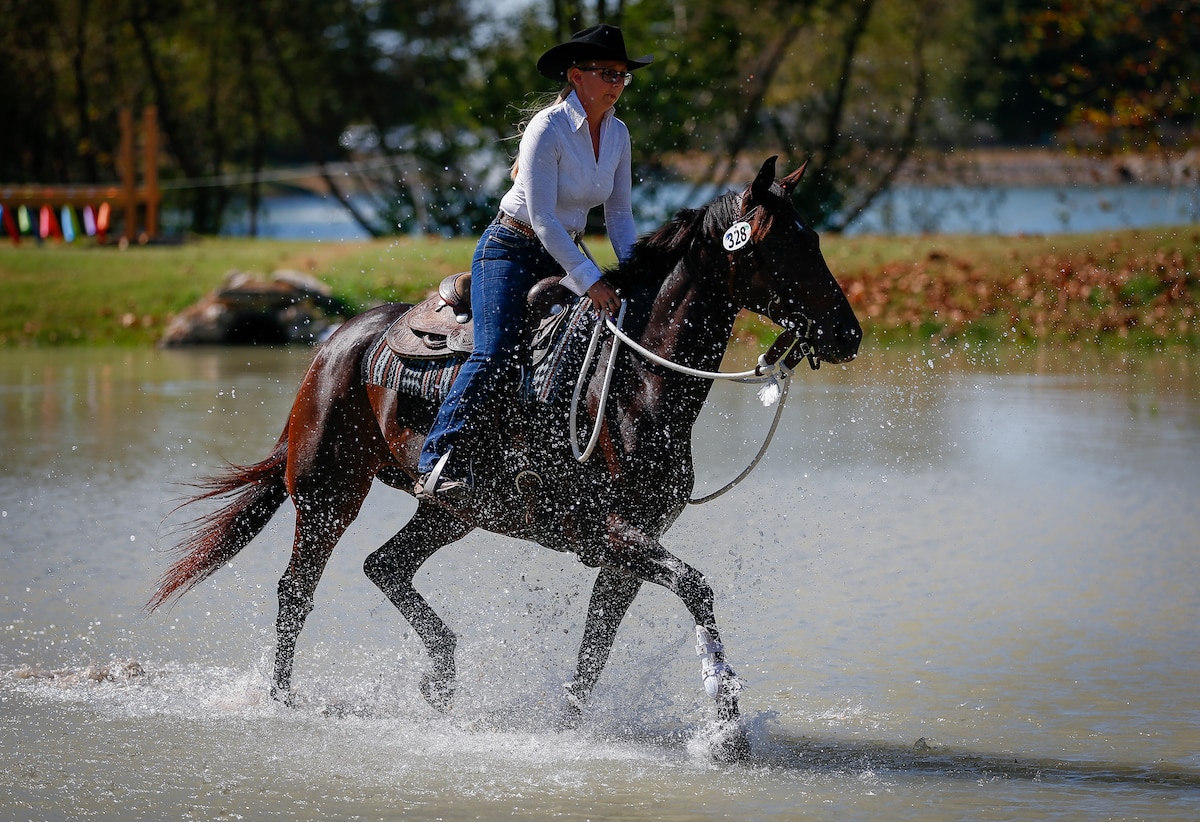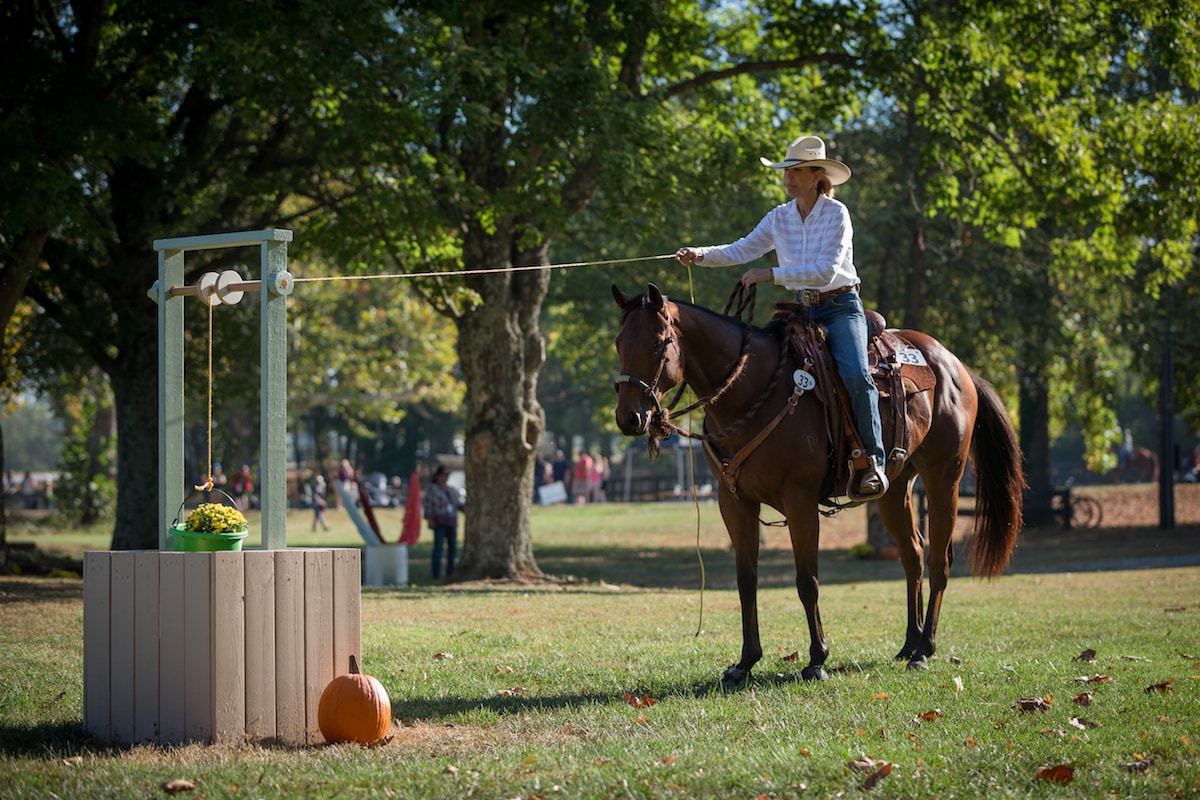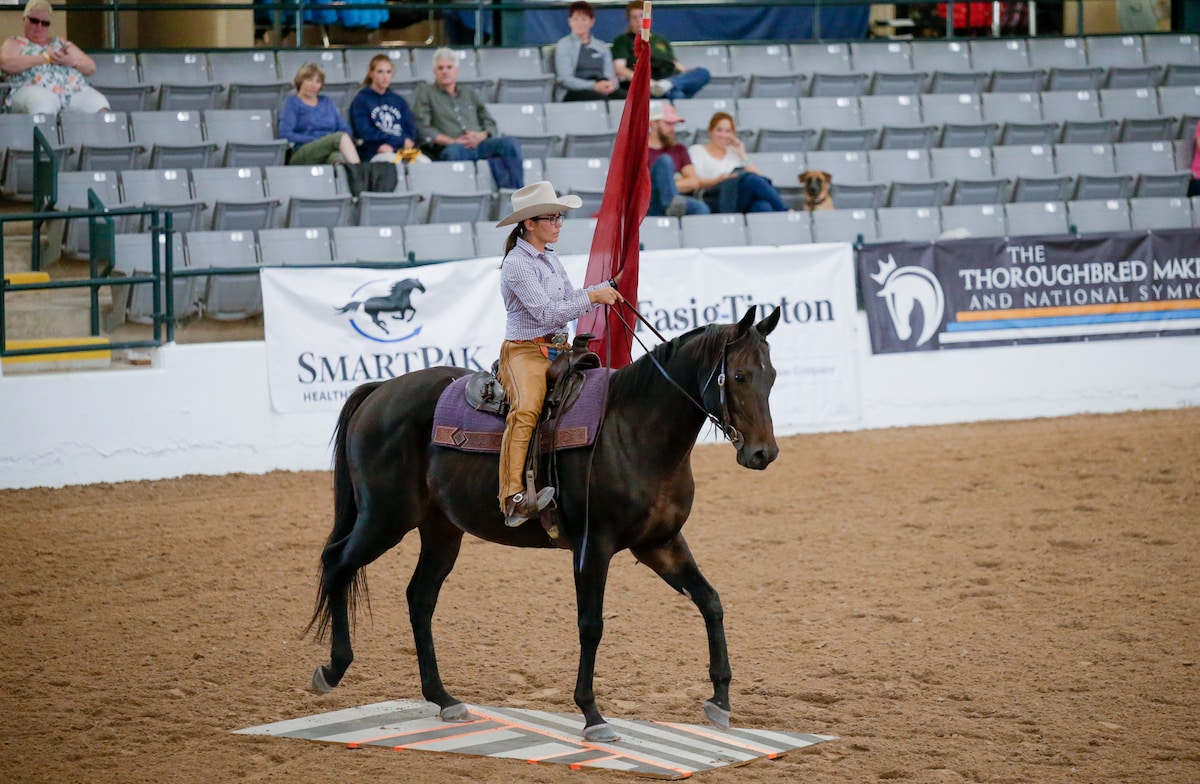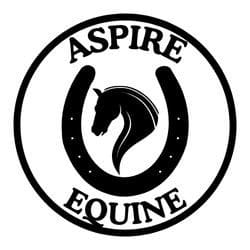The sport helps OTTBs build confidence and gives them a strong foundation for nearly any other discipline

Courtesy Canterclix
For some people trail riding means leisurely horseback strolls down sun-dappled paths. For those involved in the discipline competitively, trail involves far more skill and training than simply walking over logs and crossing streams.
Since the Retired Racehorse Project added Competitive Trail to its roster of Thoroughbred Makeover disciplines in 2015, many trainers have discovered the challenges and benefits of the sport. For off-track Thoroughbreds, in particular, it serves as a confidence- and relationship-building exercise as horses transition into new careers. Don’t be fooled into thinking trail is easy, though; while welcoming and rewarding, it’s anything but.
What Is It?
To be clear, the organized sport of competitive trail differs from the Thoroughbred Makeover’s version. Competitive trail is a timed event akin to endurance racing, in which horses and riders cover many miles over several days. What the RRP has conceived is more like an obstacle trail challenge: Riders navigate a course of obstacles resembling objects or situations they might encounter on the trail.
“Trail is about the harmony between horse and rider going through, over and under many different obstacles,” says Amy Lent, of Versailles, Kentucky, a Makeover veteran who has designed and managed trail classes for 4-H, open shows and the RRP. “It can be anything you might see on the trail plus more to see how well-trained your horse is. It can include bridges, water crossings, backing, sidepassing, carrying objects, dragging objects, optical illusions and many other obstacles.”
Each station on the trail course is designed to test the horse and rider’s ability to work together as a team, explains Chris Pepplitsch, of Lexington, Kentucky, who grew up in a racing family and worked in the industry for several decades. Today she participates in and helps organize trail challenges and has served as both course designer and steward for Competitive Trail at the Makeover.
At traditional trail challenges, she says, one or more judges at each obstacle evaluate the rider’s skill and the horse’s disposition and acceptance of cues.
“Riders are judged on harmony between horse and rider, the willingness of the horse and how well they executed the obstacles,” says Lent. “They need to be relaxed but brave through each obstacle, keeping a steady rhythm with subtle cues. Horse and rider are scored separately.”
At the Makeover, on the other hand, judges only assess the horse. “We’re looking at how the horse responds to the rider’s cue, whether that’s a leg cue or another type of cue,” says Pepplitsch. “Are they accepting to being asked to go forward? We want to see a horse that’s willing, brave, surefooted and seems to be happy. We want to see a horse that’s accepting of the movement you’re asking for.”
Take an obstacle that requires backing up, for instance. Judges want to see a horse that’s collected, lifting his back and stepping well underneath himself with his hind legs, not one with his head in the air and back hollowed.
“Trail has been an overlooked class at the Makeover with many people thinking it could be an easy second discipline, but it is more challenging than people think,” says Lent.

Toni Harmon demonstrates the proper way to use a rope to pull or drag something in competitive trail: without wrapping it around your hand. Courtesy Canterclix
Obstacles for All Disciplines
Competitive trail isn’t an avenue solely for recreational riders and those looking to turn their OTTBs into trail horses. Training a horse to navigate obstacles hones your horsemanship skills and instills in your mount confidence, willingness, agility and other attributes that will benefit whatever discipline you pursue.
“It helps build a really solid-citizen horse and will definitely humble any trainer,” says Pepplitsch.
Obstacle work, be it in-hand or under saddle, in an arena or miles down a trail, also helps horses develop trust and connections with their new trainers after coming off the track.
“It’s about building relationships, really,” Pepplitsch says. “Your horse needs to be confident in you, and you need to be confident in your horse, and you build that relationship over time. They’re looking to you for answers, and when you help them find that answer and they realize there’s no harm, you start building that relationship, that trust.”
It also serves as a useful outlet for horses beginning their training in other disciplines. “It stimulates them and helps them focus in a totally different way (than they would in) other disciplines,” says Lent.
In fact, consider adding obstacle work to your horse’s routine once a week or a couple of times a month. “It really helps your horse’s brain … and it keeps them from getting sour,” says Pepplitsch. “You can trot over poles and small jumps all day long in an arena, but a lot of horses are going to get bored. This challenges them and gives them something new to think about.”
Obstacles can help strengthen your horse physically, as well, encouraging him to use different muscle groups than he would in dressage or jumping, for instance, and fostering surefootedness.
“We want trail horses to be responsible for their own feet,” Pepplitsch explains. “When they walk over a bridge, we don’t want to have to tell them every step of the way over it what they should be doing.”
The more you practice these types of activities, the more your horse will take ownership of where he’s putting his hooves, she says.
Lastly, trail exercises can help you, as a rider, improve your equitation and balance. “Your natural feel for the horse improves because you’re more focused on working over that obstacle than what you look like in front of a dressage judge,” Pepplitsch says.
How to Practice at Home
Practicing trail courses on the farm is surprisingly easy. You don’t need a ton of land or fancy contraptions, and you don’t even need to build any obstacles. Why? Because to a horse, everything is an obstacle, says Pepplitsch.
“You can design a course in your pasture, arena, just about anywhere you have a little space — I use my front yard,” she says.
She and Lent listed a few of the common obstacles and everyday items you can use:
■ Bridges These wooden obstacles that horses must step up onto and walk across vary in size and can be purchased or built.
■ Brush Collect and place downed branches in small piles (first checking for sharp sticks that could cause injury), and ask your horse to walk over them.
■ Checkerboards Paint a checkerboard design (which creates an optical illusion) onto a piece a plywood, and encourage your horse to walk over it.
■ Empty feed bag Fill a feed sack with empty cans, tie it shut and use a long rope to drag it behind your horse (first introduce this prop on the ground). “At first they probably aren’t going to like the noise, and it’s going to be very worrisome, but you’d be surprised how soon they come to accept it,” says Pepplitsch. Just remember to never wrap the rope around your hand while dragging it.
■ Flags A common prop in the trail world, flags fly, flutter and float, making them excellent desensitization tools.
■ Gates Practice opening and closing gates while mounted.
■ Ground poles “Poles and logs can be put to many different patterns to make sure horses learn to pick their feet up well,” says Lent.
■ Mattresses Walk your horse over small, old mattresses to get him used to that squishy feeling under his feet. “We want horses to be able to accept all kinds of terrain, be that water, mud or boggy spots on the trail.” Pepplitsch says.
■ Pool noodles You can use these in a variety of ways, including affixing them to sets of jump standards your horse must walk through.
■ Tarps Once your horse learns to walk confidently over a tarp, place empty water bottles or pieces of an old water hose on it to create noise and new stimuli.
■ Umbrella Open and close it, lift it up and down and spin it around to help desensitize your horse.
■ Water “Water crossings can be natural or a water box and can have a board with holes that shoot water up when the horse steps on it,” says Lent. If you don’t have a natural water option, walk through puddles after a heavy rain.
In addition to obstacles, says Lent, work on precise transitions between gaits, sidepassing over an object, such as a pole, and backing between and around things, including up and down hills. You might be asked to perform any of these exercises on course.
If you do decide to construct your own obstacles, keep safety in mind. “Make sure there are no sharp edges, slippery surfaces or things that can get tangled up in legs and shoes,” says Pepplitsch.

Common trail props include flags and checkerboards, like 2019 Competitive Trail finalists Sami Malik and Down Town Kitty are using here. Courtesy Canterclix
Go Slow, Reward Small Victories
When introducing trail concepts and obstacles to an OTTB, start with groundwork and take your time.
“Don’t ask for too much too soon,” says Pepplitsch. “Every time you get that horse out to work with him, you’re trying to build on what you did before without destroying his trust. You’re trying to grow it as you go.”
Say, for instance, your horse snorts and backs away from a bridge or pedestal the first time you approach it. When he finally walks up and calmly puts his nose on it, “take it as a win,” she says. The next day he might get a little closer, the next he might paw at it, and eventually he’s going to place a foot up on it.
“As you go, they start to realize that this isn’t going to hurt and that you’re going to reward them,” Pepplitsch says. “Once you get past that initial fear and the horse starts to relax, the positive things start happening more quickly. They get more and more confident and willing, and the relationship just blossoms. It’s definitely a team sport between the horse and rider.”
Ways to Get Involved
If you want to practice competitive trail and participate in events, several regional and national organizations offer easy ways to get involved, including:
■ 4-H clubs, which often teach groundwork obstacle courses.
■ Open shows, which usually offer obstacle or trail classes for various skill levels and breeds.
■ Equine Trail Sports, which hosts in-hand arena challenges as well as ridden trail challenges at various levels all over the United States.
■ International Mountain Trail Challenge Association, which also has varying levels of in-hand and ridden challenges. Many host properties have permanent courses you can practice over.
■ Extreme Cowboy Association races, which are timed and conducted in an arena or open area.
■ Working equitation events, which combine classical horsemanship and dressage principles with ranch work and obstacles.
The wonderful thing about trail competitions is they are open to any type of horse, under any kind of tack. Consider volunteering or spectating at an event first, then tackling it with your OTTB.










